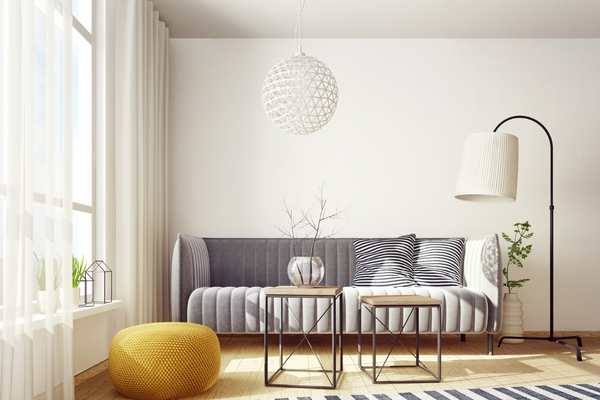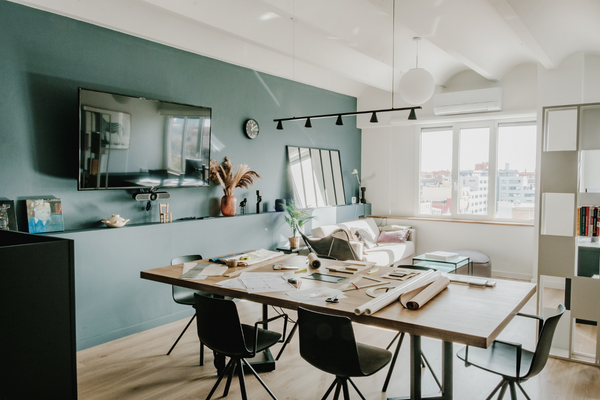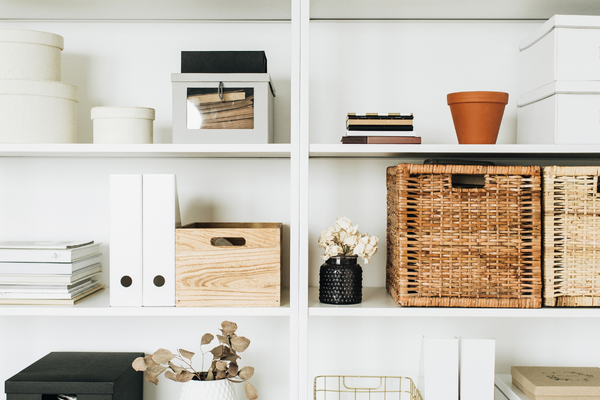“Thinking about design is hard, but not thinking about it can be disastrous.”
-Ralph Caplen
Interior design is a fascinating field that combines artistry, functionality, and creativity to transform spaces into beautiful, functional, and harmonious environments. Whether you’re a professional interior designer in London or someone who loves decorating their living space, understanding key internal design terms can be immensely helpful. These terms provide you with a common language for discussing design concepts and enhance your ability to appreciate and communicate about the world of interior design. In this blog, we’ll explore 27 essential interior design term definitions that you should know.
1. Focal Point
A central point in interior design is to attract attention and serve as a room’s main visual focal point. Artwork, furniture or architectural elements are frequently used to achieve this. A focal point can be anything out of place in the rest of the room, such as an edgy piece of art, a statement fireplace or some unique furniture.
2. Colour Palette
A carefully selected range of colours is used in a design project to create a cohesive and harmonious look. The mood, scale, natural light, existing furniture, and décor are to be considered when selecting colours.
3. Balance
The distribution of visual weight in a room is achieved through symmetrical or asymmetrical arrangements of elements. In interior design, Balance is crucial to create a sense of harmony and stability in the space. A well-balanced room can feel comfortable and inviting, but an unbalanced room feels messy and overwhelming.
4. Texture
The tactile quality of surfaces in a space, which can be smooth, rough, glossy, matte, etc., contributes to the overall sensory experience. It is a very important element of interior design since it can be used for creating different moods and atmospheres. You can create an area that is both attractive and comfortable for living in through the use of textures in your home design.
5. Scale
The proportion of objects and elements within a space, ensuring they relate harmoniously to one another and the room’s size. It helps achieve a sense of equilibrium and proportion in the space, which can be helpful when designing a space. Create an impression of interest and depth by using the scale.
6. Contrast
The juxtaposition of different elements, such as colours, textures, or styles, creates visual interest and drama. It can produce a wide range of moods and atmospheres. The contrast highlights your finest features, making movement and rhythm. There are no defined rules for contrast in interior design. Most importantly, choose the pieces you love that make a room look comfortable and welcoming.
7. Mood Board Design
A collection of images, materials, and colours that convey a design project’s desired aesthetic and atmosphere. It is a tool designers use to communicate their visions to clients and explore various ideas and concepts. You can improve the clarity of your design project and share ideas more effectively with other people by creating a mood board designs.
8. Eclectic
A style that combines elements from various design styles and eras to create a unique and personalized look. This style does not shy away from mixing and matching patterns, colours or textures. Eclectic interiors reflect the individual’s taste and personality, which is why they are often eclectic.
9. Minimalism
A design philosophy characterised by simplicity, clean lines, and a focus on essential elements, often resulting in a clutter-free and serene space. The idea that less is more is what Minimalism is all about. There is usually no unnecessary clutter or ornamentation in the Minimalist interior. Mainly focusing on the fundamental elements of a space, such as furniture, lighting and art.
10. Transitional
This design style that bridges traditional and contemporary aesthetics, blending classic and modern elements for a balanced look, is often called “Transitional Design.” It’s a popular choice for homeowners looking for an enduring and sophisticated space that is comfortable and inviting.
The transitional design seamlessly combines elements from different eras and design philosophies, creating a timeless and harmonious interior that can incorporate features from various styles, including retro pop art, and even subtle Art Deco influences.
11. Hue
The pure colour on the colour wheel, such as red, blue, or green. In addition to value and saturation, it’s one of the three essential elements in colour. The wavelength of light determines the spectral quality of the colour, which is reflected or emitted by the object.
12. Value
The lightness or darkness of a colour is achieved by adding black or white, which affects the colour’s intensity and depth. The value may also be used to generate a variety of tones in the color. To make it less saturated, a tone is a colour mixed with grey.
13. Proportion
The relationship between different elements’ sizes in a space ensures visual harmony and Balance. To produce a feeling of scale, hierarchy and rhythm in the composition, proportion can be used.
14. Rhythm
The repetition of design elements, like patterns or shapes, creates a sense of movement and flow within a space. For example, to produce a feeling of energy and excitement or calm and comfort, giving viewers visual guidance on the composition may be helpful.
15. Ambience
Factors like lighting, colours, and furnishings influence a room’s overall atmosphere or feeling. Ambience can produce various effects, from mild comfort to stimulation or an active and energetic atmosphere.
16. Architectural Detail
The distinctive features and elements of a building’s structure, such as mouldings, trim, or columns, can be enhanced or incorporated into interior design. They can improve its character, interest and eye appeal in a space. The Balance of architectural details in the space should also be considered. Too many details may be overwhelming, while too few can dull a room.
17. Open Floor Plan
A design layout that combines multiple living spaces into one, typically featuring a seamless flow between the kitchen, dining, and living areas. This may give people a greater sense of space and air and make it easier to interact with one another.
18. Accent Wall
A wall that is painted or decorated differently from the surrounding walls to create a focal point in a room. Accent walls may be used to create a variety of colours, patterns or textures in the space and serve as an expression of your style.
19. Transparency
Glass or translucent screens allow light and visibility between spaces while maintaining separation. Various materials, including glass, opaque screens and perforated panels, may be used to achieve this. Transparency can make your home feel brighter, more open, and more connected while still providing some privacy.
20. Art Deco
Art Deco is a designstyle popular in the 1920s and 1930s, known for its geometric shapes, luxurious materials, and a sense of luxury and opulence.
21. Cohesiveness
The quality of design elements working together to create a unified and harmonious interior. This means that a sense of Balance and flow should be made by combining various elements within the construction, e.g. colours, furniture or accessories.
22. Ergonomics
The study of designing spaces and furniture to optimize comfort and efficiency for human use. In the context of interior design, this is a valuable concept that can help draw up pleasant and productive spaces.
23. Daylighting
Using natural light sources to illuminate a space reduces the need for artificial lighting and creates a pleasant atmosphere. Let natural light enter the space is one way to do so, by using huge windows and skylights. Another way is to use reflective surfaces, such as mirrors and light shelves, to absorb natural light into the space.
24. Monochromatic
A colour scheme that uses various shades and tones of a single colour, creating a subtle and unified look. It is one of the most simple and flexible colour schemes to use, which can also be used for creating a broad range of looks from classic elegance to modern Minimalism. Creating a sophisticated and elegant look in your home with monochromatic colour schemes is a great way to do this.
25. Mullion
The horizontal or vertical dividing bars in windows and doors are the mullions. They may be necessary in creating a whole space’s style and appearance. Narrow mullions, on the other hand, give a sleek and modern appearance, while broad mullions can be more typical or rustic.
26. Crown Molding
Decorative moulding is installed along the top edge of walls, where the wall meets the ceiling, to add elegance and detail to a room. Crown moulding can add beauty to any room, but you must select the right height and shape for your space. A simple crown moulding with a low profile, for example, might be the choice if you’re in a small room. You can select an even more elegant crown moulding with a higher profile if you are in a big room.
27. Traffic Flow
The furniture and elements arrangement in a space ensures smooth and convenient movement throughout the room. Consider how people will move around the room when you arrange furniture. It is necessary to leave sufficient space between the furniture pieces so people can proceed comfortably. Use area rugs to determine various areas of a room and create an impression of flow.
These 27 interior design terms provide a foundation for understanding the language of design and can empower you to make informed decisions when planning and decorating your living spaces. Whether you’re embarking on a significant design project or simply looking to refresh your home, knowing these terms will help you communicate your ideas effectively and create interiors that are not only aesthetically pleasing but also functional and comfortable. Interior design is an ever-evolving field, so the more you know, the better equipped you’ll be to create beautiful and inspiring spaces. Boldly enrich your interior design journey with Oraanj Interior Design.
Author: Gunjan Khemka & Rutuja Borade (Interior Designer)





